Systems and topology overview
IBM® UrbanCode® Deploy includes several systems, including a server and one or more agents. You can configure multiple topologies, including ones that use high availability, disaster recovery, and the blueprint designer, to meet your needs.
The following system topologies, including diagrams, are shown. For explanation of the system components, see the Description of systems.
Core topology
The core installation of IBM UrbanCode Deploy includes a server, agents, and a license server. Clients access the server through web browsers, the REST API, or the command-line client. Agents can be installed on cloud environments, virtual machines (VMs), containers, or physical systems; the agents are shown on cloud systems in the following diagrams, but they can be installed on many different systems.With this topology, the server can create environments on clouds that use virtual system patterns (VSPs), such as IBM Cloud Orchestrator and IBM PureApplication® System. To create environments on other clouds such as Amazon Web Services, SoftLayer®, VMware vCenter, and Microsoft™ Azure, you must install the blueprint design server and at least one engine, as described in the blueprint design topologies.
For more information about supported clouds that use VSPs, see Modeling environments for clouds that use virtual system patterns.
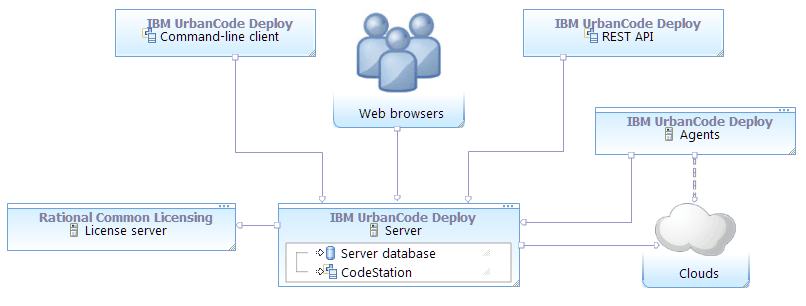
Blueprint design topologies
To work with blueprints on clouds via OpenStack Heat, including OpenStack-based clouds, Amazon Web Services, SoftLayer, VMware vCenter, and Microsoft Azure, you must apply a topology that includes the blueprint design server and engine. (In previous versions, these systems were part of IBM UrbanCode Deploy with Patterns.)Installing a standalone engine
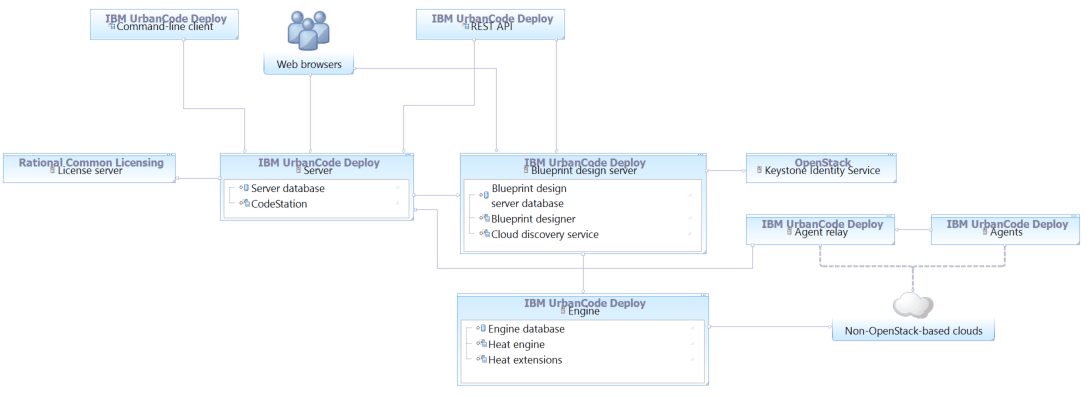
Extending Heat orchestration engines
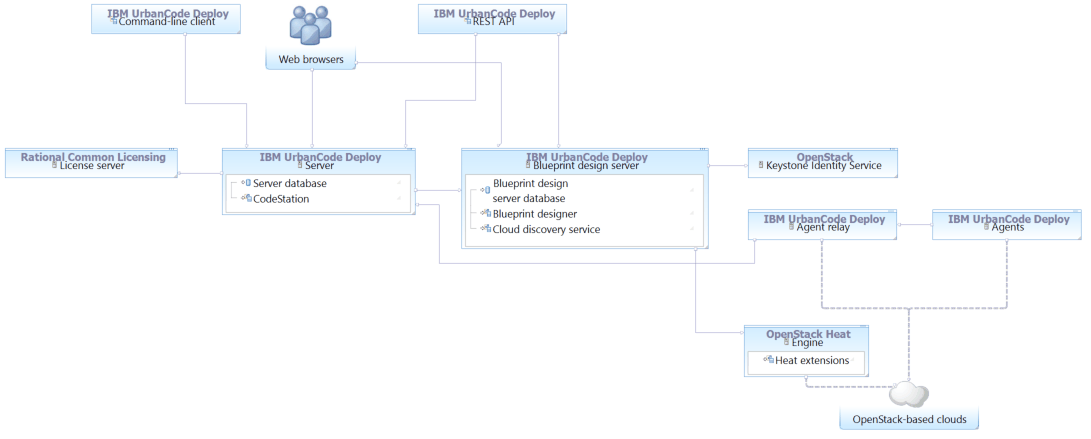
Multi-region topology
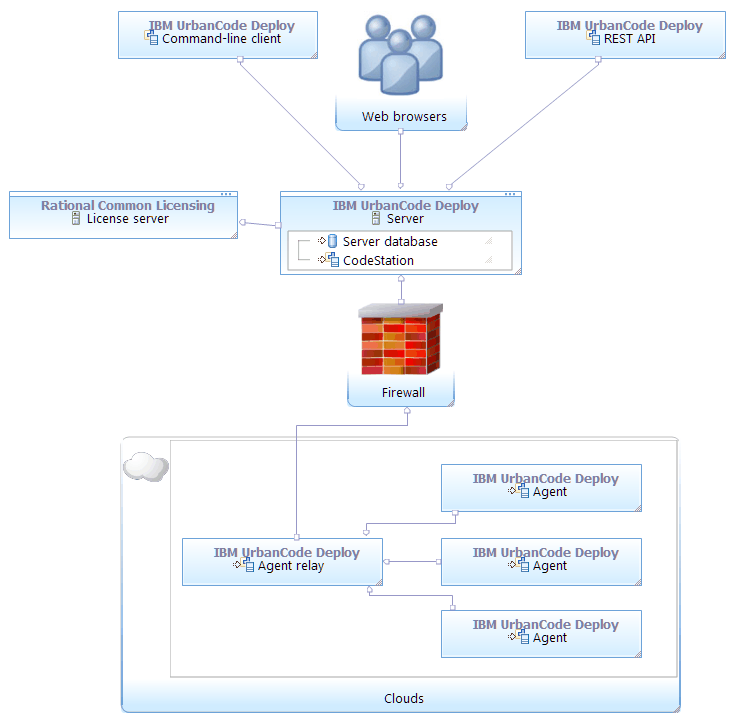
To install and configure an agent relay, see Installing agent relays.
High-availability clustered topologies
High-availability topologies use multiple servers. These servers can all be running at the same time to share the load (as in a clustered topology), or they can be waiting for another server to fail (as in a cold standby topology). The following diagram shows a clustered topology in which a load balancer distributes connections to three servers. Users connect directly to the load balancer, which sends them to an active server. Agents connect via HTTP and HTTPS to the load balancer; however, the agents connect via JMS directly to the servers. The servers store their files on a shared database and file system.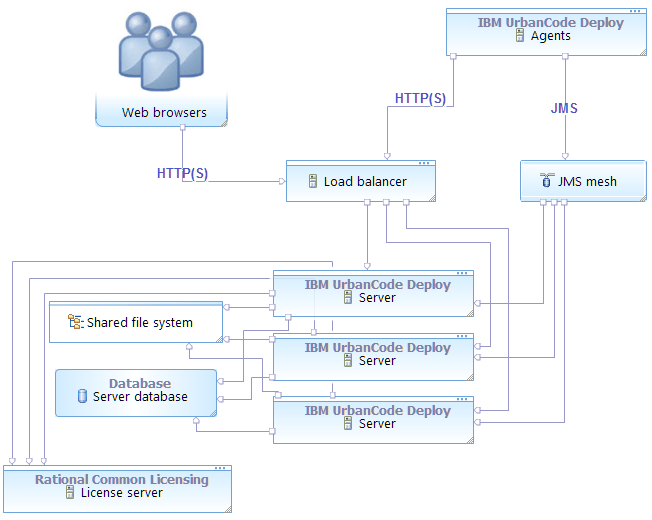
To configure a cluster of servers, see Setting up clusters of servers.
You can also cluster blueprint design servers and engines. In this case, you install one or more blueprint design servers and engines, and set them each to access the same database and shared file system. Similarly, a load balancer distributes traffic to the blueprint design servers and engines. The following diagram shows a clustered topology with three engines and three blueprint design servers, connecting to one or more non-OpenStack clouds:
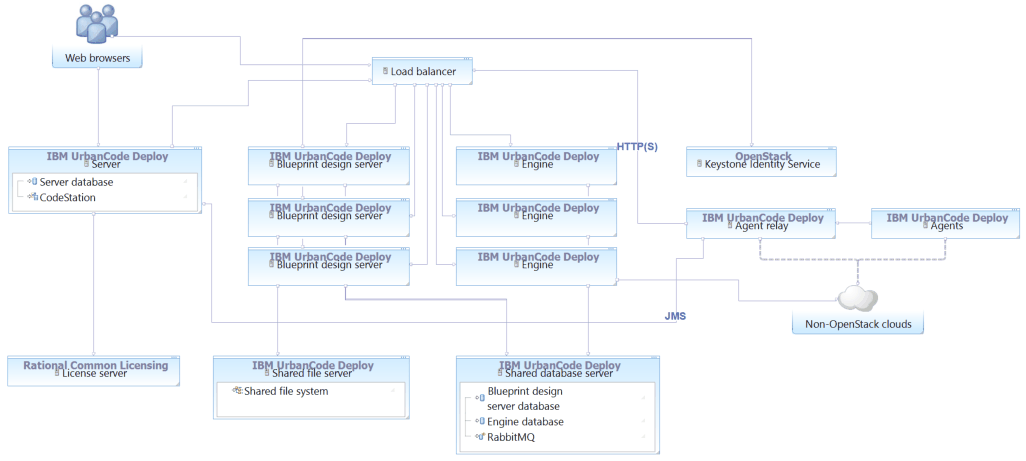
To connect to OpenStack-based clouds, the topology is different because the Heat engines are installed via the OpenStack server, not via IBM UrbanCode Deploy:
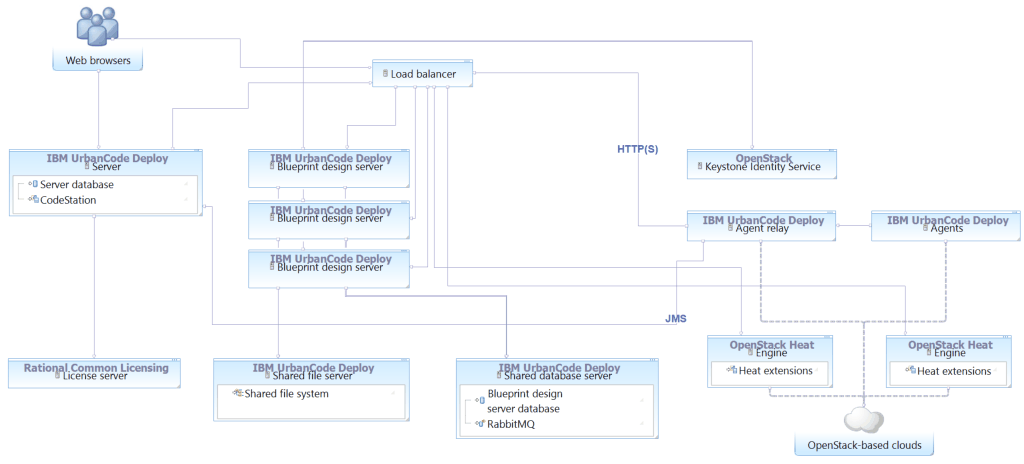
To configure a cluster of blueprint design servers and engines, see Setting up clusters of blueprint design servers and Setting up clusters of engines.
Disaster recovery topologies
One way to prepare for disaster recovery is to have a cold standby system, including a stopped server and a replicated copy of the database and file system. The following diagram shows a simple topology with a cold standby server and related resources on standby.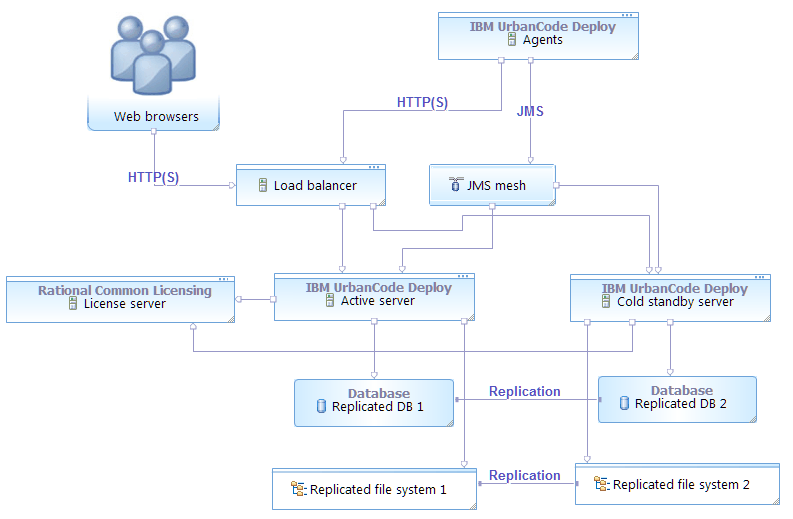
To configure a cold standby system for the server, see Adding cold standby servers.
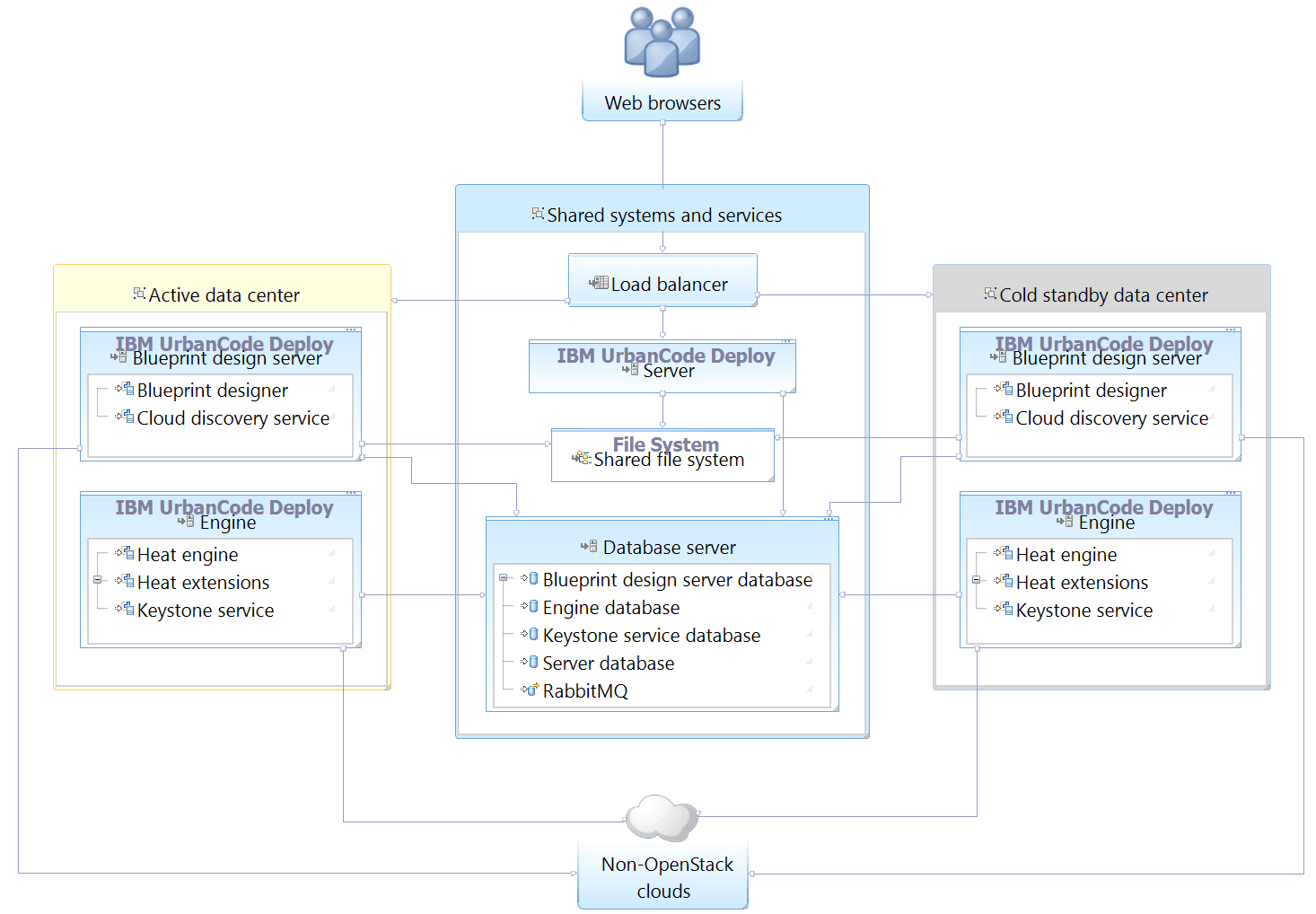
To configure disaster recovery for the blueprint designer, see Configuring disaster recovery for the blueprint design server.
Default ports

For more information about ports, see System requirements and performance considerations.
Description of systems
- IBM UrbanCode Deploy server
- The IBM UrbanCode Deploy server stores components, processes, and other elements with which you model automated application deployments. You run automated deployments from the server.
- Web browsers
- Web browsers are the main way that users interact with the server and blueprint designer. The IBM UrbanCode Deploy browser-based GUI is a Rich Internet Application (RIA) that maintains much of its functionality in the browser. Clients interact with RESTful (representational state transfer) services on the server as needed.
- Command-line client
- The command-line client provides access to the server through the command line. It can automate functions on the server, such as creating components and applications, and provides most of the features that are found in the browser-based GUI. The command-line client is also built on top of RESTful services. See Command-line client (CLI) reference.
- REST API
- The REST API provides access to the server through HTTP. Like the command-line client, it can automate functions on the server, such as creating components and applications.
- Agents
- The agents run processes on target systems. Agents can run on physical computers, virtual systems, or cloud systems. See Agents.
- Agent relays
- An agent relay is a communication proxy for agents that are located behind a firewall or in another network location. See Agent relays.
- Blueprint design server
- This server hosts the blueprint designer and controls access to blueprints, the files that describe network topology for applications that you provision to different clouds. It also hosts the cloud discovery service, which provides information about the available cloud resources to the blueprint designer. (In previous versions, this system was the IBM UrbanCode Deploy with Patterns design server.) For more information about using the blueprint designer, see Modeling environments for clouds through OpenStack Heat.
- Engine
- The Heat engine is an installation of the OpenStack Heat orchestration engine with IBM extensions. The engine manages cloud infrastructure, provisioning resources from clouds, updating those resources, and deleting them. To connect to non-OpenStack clouds, you install the Heat engine that is provided with IBM UrbanCode Deploy, which includes the extensions. To connect to OpenStack clouds, you extend an existing Heat engine by adding the extensions to it. (In previous versions, this system was the IBM UrbanCode Deploy with Patterns Heat engine.)
- Rational® Common Licensing license server
- The license server provides licenses to the server. For more information on the license server, see IBM Rational Common Licensing.
- Keystone Identity Service
- This service provides authentication tokens to the OpenStack system. The blueprint design server requires it. If you do not have a Keystone service, you can use one that is provided with the Heat engine.
- Clouds
- The clouds host virtual resources. When you create environments with blueprints, the server or engine provisions resources on the target clouds. For information about supported clouds, see Integrating with cloud systems.
- CodeStation
- CodeStation stores component versions and artifacts. It is part of the IBM UrbanCode Deploy server.